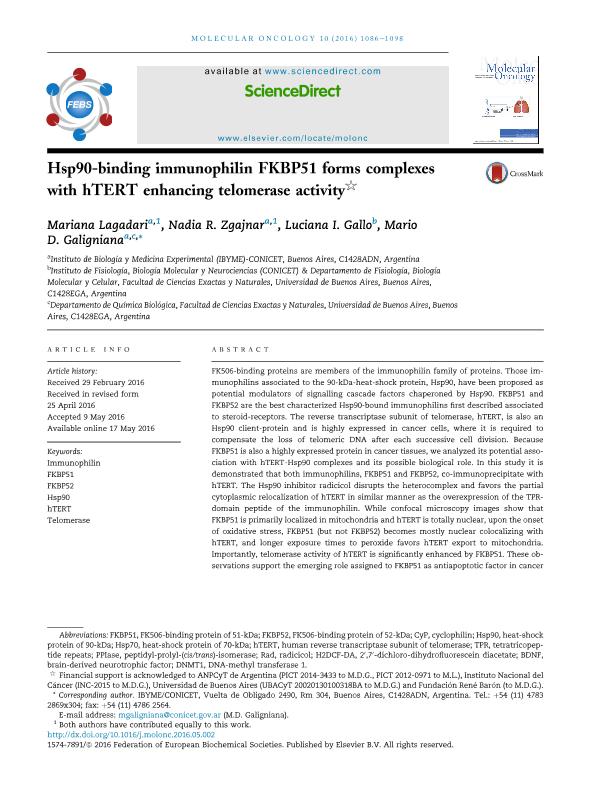Mostrar el registro sencillo del ítem
dc.contributor.author
Lagadari, Mariana

dc.contributor.author
Zgajnar, Nadia Romina

dc.contributor.author
Gallo, Luciana Ines

dc.contributor.author
Galigniana, Mario Daniel

dc.date.available
2017-09-12T18:12:08Z
dc.date.issued
2016-05-17
dc.identifier.citation
Lagadari, Mariana; Zgajnar, Nadia Romina; Gallo, Luciana Ines; Galigniana, Mario Daniel; Hsp90-binding immunophilin FKBP51 forms complexes with hTERT enhancing telomerase activity; Elsevier; Molecular Oncology; 10; 7; 17-5-2016; 1086-1098
dc.identifier.issn
1574-7891
dc.identifier.uri
http://hdl.handle.net/11336/24041
dc.description.abstract
FK506-binding proteins are members of the immunophilin family of proteins. Those immunophilins associated to the 90-kDa-heat-shock protein, Hsp90, have been proposed as potential modulators of signalling cascade factors chaperoned by Hsp90. FKBP51 and FKBP52 are the best characterized Hsp90-bound immunophilins first described associated to steroid-receptors. The reverse transcriptase subunit of telomerase, hTERT, is also an Hsp90 client-protein and is highly expressed in cancer cells, where it is required to compensate the loss of telomeric DNA after each successive cell division. Because FKBP51 is also a highly expressed protein in cancer tissues, we analyzed its potential association with hTERT·Hsp90 complexes and its possible biological role. In this study it is demonstrated that both immunophilins, FKBP51 and FKBP52, co-immunoprecipitate with hTERT. The Hsp90 inhibitor radicicol disrupts the heterocomplex and favors the partial cytoplasmic relocalization of hTERT in similar manner as the overexpression of the TPR-domain peptide of the immunophilin. While confocal microscopy images show that FKBP51 is primarily localized in mitochondria and hTERT is totally nuclear, upon the onset of oxidative stress, FKBP51 (but not FKBP52) becomes mostly nuclear colocalizing with hTERT, and longer exposure times to peroxide favors hTERT export to mitochondria. Importantly, telomerase activity of hTERT is significantly enhanced by FKBP51. These observations support the emerging role assigned to FKBP51 as antiapoptotic factor in cancer development and progression, and describe for the first time the potential role of this immunophilin favoring the clonal expansion by enhancing telomerase activity.
dc.format
application/pdf
dc.language.iso
eng
dc.publisher
Elsevier

dc.rights
info:eu-repo/semantics/openAccess
dc.rights.uri
https://creativecommons.org/licenses/by/2.5/ar/
dc.subject
Fkbp51
dc.subject
Fkbp52
dc.subject
Hsp90
dc.subject
Immunophilin I
dc.subject
Telomerase
dc.subject
Htert
dc.subject.classification
Bioquímica y Biología Molecular

dc.subject.classification
Ciencias Biológicas

dc.subject.classification
CIENCIAS NATURALES Y EXACTAS

dc.title
Hsp90-binding immunophilin FKBP51 forms complexes with hTERT enhancing telomerase activity
dc.type
info:eu-repo/semantics/article
dc.type
info:ar-repo/semantics/artículo
dc.type
info:eu-repo/semantics/publishedVersion
dc.date.updated
2017-08-31T20:31:10Z
dc.identifier.eissn
1878-0261
dc.journal.volume
10
dc.journal.number
7
dc.journal.pagination
1086-1098
dc.journal.pais
Países Bajos

dc.journal.ciudad
Amsterdam
dc.description.fil
Fil: Lagadari, Mariana. Consejo Nacional de Investigaciones Científicas y Técnicas. Instituto de Biología y Medicina Experimental. Fundación de Instituto de Biología y Medicina Experimental. Instituto de Biología y Medicina Experimental; Argentina
dc.description.fil
Fil: Zgajnar, Nadia Romina. Consejo Nacional de Investigaciones Científicas y Técnicas. Instituto de Biología y Medicina Experimental. Fundación de Instituto de Biología y Medicina Experimental. Instituto de Biología y Medicina Experimental; Argentina
dc.description.fil
Fil: Gallo, Luciana Ines. Consejo Nacional de Investigaciones Científicas y Técnicas. Oficina de Coordinación Administrativa Ciudad Universitaria. Instituto de Fisiología, Biología Molecular y Neurociencias. Universidad de Buenos Aires. Facultad de Ciencias Exactas y Naturales. Instituto de Fisiología, Biología Molecular y Neurociencias; Argentina
dc.description.fil
Fil: Galigniana, Mario Daniel. Consejo Nacional de Investigaciones Científicas y Técnicas. Instituto de Biología y Medicina Experimental. Fundación de Instituto de Biología y Medicina Experimental. Instituto de Biología y Medicina Experimental; Argentina. Universidad de Buenos Aires. Facultad de Ciencias Exactas y Naturales. Departamento de Química Biológica; Argentina
dc.journal.title
Molecular Oncology

dc.relation.alternativeid
info:eu-repo/semantics/altIdentifier/url/http://www.sciencedirect.com/science/article/pii/S1574789116300369
dc.relation.alternativeid
info:eu-repo/semantics/altIdentifier/doi/http://dx.doi.org/10.1016/j.molonc.2016.05.002
dc.relation.alternativeid
info:eu-repo/semantics/altIdentifier/url/https://www.ncbi.nlm.nih.gov/pmc/articles/pmid/27233944/
Archivos asociados
